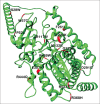Molecular genetics of primary open-angle glaucoma
- PMID: 37203025
- PMCID: PMC10391438
- DOI: 10.4103/IJO.IJO_2570_22
Molecular genetics of primary open-angle glaucoma
Abstract
Glaucoma is a series of linked optic diseases resulting in progressive vision loss and total blindness due to the acquired loss of retinal ganglion cells. This harm to the optic nerve results in visual impairment and, ultimately, total blindness if left untreated. Primary open-angle glaucoma (POAG) is the most frequent variety within the large family of glaucoma. It is a multifaceted and heterogeneous condition with several environmental and genetic variables aiding in its etiology. By 2040, there will be 111.8 million glaucoma patients globally, with Asia and Africa accounting for the vast majority. The goal of this review is to elaborate on the role of genes (nuclear and mitochondrial) as well as their variants in the pathogenesis of POAG. PubMed and Google Scholar databases were searched online for papers until September 2022. Prevalence and inheritance patterns vary significantly across different ethnic and geographic populations. Numerous causative genetic loci may exist; however, only a few have been recognized and characterized. Further investigation into the genetic etiology of POAG is expected to uncover novel and intriguing causal genes, allowing for a more precise pathogenesis pattern of the disease.
Keywords: Cytochrome P450; genetics; myocilin; optineurin; primary open-angle glaucoma.
Conflict of interest statement
None
Figures









References
-
- Huang X, Li M, Guo X, Li S, Xiao X, Jia X, et al. Mutation analysis of seven known glaucoma-associated genes in Chinese patients with glaucoma. Investig Ophthalmol Vis Sci. 2014;55:3594–602. - PubMed
-
- Bourne RRA, Stevens GA, White RA, Smith JL, Flaxman SR, Price H, et al. Causes of vision loss worldwide, 1990-2010:A systematic analysis. Lancet Glob Health. 2013;1:e339–49. - PubMed
-
- Tham YC, Li X, Wong TY, Quigley HA, Aung T, Cheng CY. Global prevalence of glaucoma and projections of glaucoma burden through 2040:A systematic review and meta-analysis. Ophthalmology. 2014;121:2081–90. - PubMed
Publication types
MeSH terms
LinkOut - more resources
Full Text Sources

